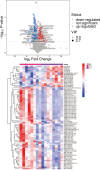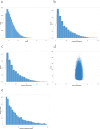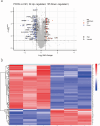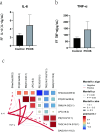Integrated lipid metabolomics and proteomics analysis reveal the pathogenesis of polycystic ovary syndrome
- PMID: 38632610
- PMCID: PMC11022415
- DOI: 10.1186/s12967-024-05167-x
Integrated lipid metabolomics and proteomics analysis reveal the pathogenesis of polycystic ovary syndrome
Abstract
Background: Polycystic ovary syndrome (PCOS) is an endocrinological and metabolic disorder that can lead to female infertility. Lipid metabolomics and proteomics are the new disciplines in systems biology aimed to discover metabolic pathway changes in diseases and diagnosis of biomarkers. This study aims to reveal the features of PCOS to explore its pathogenesis at the protein and metabolic level.
Methods: We collected follicular fluid samples and granulosa cells of women with PCOS and normal women who underwent in vitro fertilization(IVF) and embryo transfer were recruited. The samples were for the lipidomic study and the proteomic study based on the latest metabolomics and proteomics research platform.
Results: Lipid metabolomic analysis revealed abnormal metabolism of glycerides, glycerophospholipids, and sphingomyelin in the FF of PCOS. Differential lipids were strongly linked with the rate of high-quality embryos. In total, 144 differentially expressed proteins were screened in ovarian granulosa cells in women with PCOS compared to controls. Go functional enrichment analysis showed that differential proteins were associated with blood coagulation and lead to follicular development disorders.
Conclusion: The results showed that the differential lipid metabolites and proteins in PCOS were closely related to follicle quality,which can be potential biomarkers for oocyte maturation and ART outcomes.
Keywords: Biomarker; Follicular fluid; Granulosa cells; Lipid metabolomics; Polycystic ovary syndrome; Proteomics.
© 2024. The Author(s).
Conflict of interest statement
The authors declare that the research was conducted in the absence of any commercial or financial relationships that could be construed as a potential conflict of interest.
Figures







Similar articles
-
Follicular fluid lipidomics analysis reveals altered lipid signatures in patients with polycystic ovary syndrome.J Obstet Gynaecol. 2024 Dec;44(1):2378489. doi: 10.1080/01443615.2024.2378489. Epub 2024 Jul 17. J Obstet Gynaecol. 2024. PMID: 39016329
-
Multi-omics approach to reveal follicular metabolic changes and their effects on oocyte competence in PCOS patients.Front Endocrinol (Lausanne). 2024 Oct 11;15:1426517. doi: 10.3389/fendo.2024.1426517. eCollection 2024. Front Endocrinol (Lausanne). 2024. PMID: 39464191 Free PMC article.
-
Follicular fluid lipidomic profiling reveals potential biomarkers of polycystic ovary syndrome: A pilot study.Front Endocrinol (Lausanne). 2022 Sep 13;13:960274. doi: 10.3389/fendo.2022.960274. eCollection 2022. Front Endocrinol (Lausanne). 2022. PMID: 36176459 Free PMC article.
-
Disturbed Follicular Microenvironment in Polycystic Ovary Syndrome: Relationship to Oocyte Quality and Infertility.Endocrinology. 2024 Feb 20;165(4):bqae023. doi: 10.1210/endocr/bqae023. Endocrinology. 2024. PMID: 38375912 Review.
-
Unraveling the complexity of follicular fluid: insights into its composition, function, and clinical implications.J Ovarian Res. 2024 Nov 26;17(1):237. doi: 10.1186/s13048-024-01551-9. J Ovarian Res. 2024. PMID: 39593094 Free PMC article. Review.
Cited by
-
Nicotinamide Mononucleotide Alleviates Bile Acid Metabolism and Hormonal Dysregulation in Letrozole-Induced PCOS Mice.Biology (Basel). 2024 Dec 8;13(12):1028. doi: 10.3390/biology13121028. Biology (Basel). 2024. PMID: 39765695 Free PMC article.
-
Decoding androgen excess in polycystic ovary syndrome: Roles of insulin resistance and other key intraovarian and systemic factors.World J Diabetes. 2025 Jul 15;16(7):108789. doi: 10.4239/wjd.v16.i7.108789. World J Diabetes. 2025. PMID: 40697592 Free PMC article. Review.
-
Is integrative therapy of traditional Chinese medicine and progesterone capsule more effective than monotherapies in oligomenorrhea and hypomenorrhea? Evidence based on a multi-center randomized controlled trial and metabolomic profile.J Transl Int Med. 2025 Jul 8;13(4):349-365. doi: 10.1515/jtim-2025-0027. eCollection 2025 Aug. J Transl Int Med. 2025. PMID: 40861072 Free PMC article.
-
The association between serum HDL levels and infertility among American women aged 20-44 years: A retrospective cross-sectional study of NHANES, 2013-2020.PLoS One. 2024 Oct 7;19(10):e0311618. doi: 10.1371/journal.pone.0311618. eCollection 2024. PLoS One. 2024. PMID: 39374238 Free PMC article.
-
Screening of serum biomarkers in patients with PCOS through lipid omics and ensemble machine learning.PLoS One. 2025 Jan 7;20(1):e0313494. doi: 10.1371/journal.pone.0313494. eCollection 2025. PLoS One. 2025. PMID: 39775242 Free PMC article.
References
Publication types
MeSH terms
Substances
Grants and funding
LinkOut - more resources
Full Text Sources
Medical

